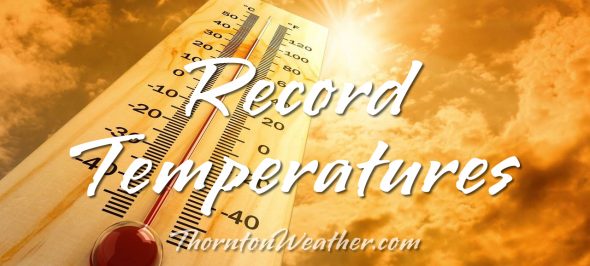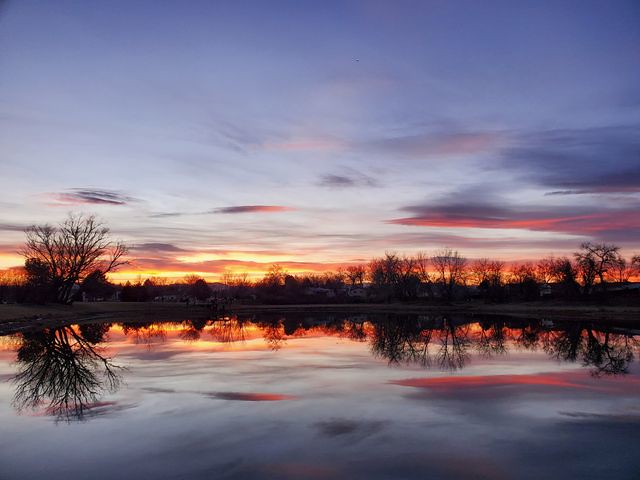
This may be the first full week of spring officially but as any longtime Colorado resident will tell you, spring-like weather is not a given this time of year. As we look back at this week in Denver weather history, it is very clear that oftentimes Old Man Winter insists on hanging around for a bit longer.
18-21
In 1907…a warm spell resulted in 6 daily temperature records. Record maximum temperatures of 82 degrees occurred on the 18th with 81 degrees on the 19th and 80 degrees on the 20th. Record high minimum temperatures of 52 degrees occurred on the 19th and 20th with 54 degrees on the 21st.
19-21
In 1888…heavy snowfall totaled 8.6 inches over downtown Denver. North winds were sustained to 27 mph on the 19th.
20-21
In 1878…warm days with high temperatures in the lower 70’s in the city…caused snow to melt on the palmer divide…which caused the waters in Cherry Creek to rise. The high…rapid running water damaged a home and eroded bridge footings and abutments. Some bridges became unsafe for the passage of trains.
In 1904…southwest winds sustained to 48 mph with gusts to 60 mph warmed the temperature to a high of 68 degrees on the 20th. The high was only 42 degrees on the 21st behind a cold front…which produced 1.3 inches of snow and northeast winds sustained to 27 mph overnight.
In 1923…post-frontal rain changed to heavy snow and totaled 8.2 inches over the city. North winds were sustained to 27 mph with gusts to 29 mph on the 20th. This was the second major snow in a week.
In 1932…rain changed to heavy snow…which totaled 6.2 inches in downtown Denver. North winds gusted to 22 mph on the 21st.
In 1948…heavy snowfall totaled 7.2 inches over downtown Denver.
In 1952…a major snow storm produced north wind gusts to 35 mph and dumped 16.9 inches of snowfall on Stapleton Airport. The maximum snow depth on the ground was 13 inches due to melting.
In 2000…heavy snow fell in and near the foothills of Douglas and Jefferson counties. Snowfall totals included: 9 inches near tiny town and 7 inches in Littleton. Snowfall totaled only 1.8 inches at the site of the former Stapleton International Airport. North winds gusted to 34 mph at Denver International Airport on the 20th.
20-22
In 1944…heavy snow fell over metro Denver for a total of 36 hours. The storm dumped 18.5 inches of snowfall over downtown Denver and 12.2 inches at Stapleton Airport. Fortunately…there were no strong winds with the storm. North winds to only 19 mph were recorded on the 21st.
21
In 1898…an apparent Canadian cold front produced strong winds and plunged temperatures from a high of 56 degrees to a low of 8 degrees late in the day. North winds were sustained to 48 mph with gusts to 60 mph.
In 1908…light snowfall of 1.3 inches produced 0.10 inch of precipitation. This…along with the 0.01 inch of precipitation on the 8th…resulted in the driest March on record with a total of 0.11 inch of precipitation.
In 1916…southwest winds were sustained to 46 mph with a gust to 48 mph. The Chinook winds warmed the temperature to a high of 62 degrees.
In 1923…heavy snowfall totaled 8.0 inches in downtown Denver.
In 1953…northwest winds gusting to 57 mph briefly reduced visibility to 3/4 miles in blowing dust at Stapleton Airport.
In 1981…rain changed rapidly to snow…but totaled only 2.8 inches at Stapleton International Airport. North winds gusting to 35 mph produced much blowing snow and reduced the visibility to a half mile at times. Over the higher elevations of south metro Denver…4 to 6 inches of snow were measured.
21-22
In 1955…wind gusts to 98 mph were recorded at Rocky Flats south of Boulder. Some damage and a few minor injuries were reported in Boulder. Northwest winds were sustained to 28 mph with gusts to 39 mph at Stapleton Airport on the 22nd.
In 1966…a vigorous cold front produced only 1.7 inches of snowfall at Stapleton International Airport…but northeast winds gusted to 49 mph on the 21st. Temperatures cooled from a maximum of 66 degrees on the 21st to a minimum of 14 degrees on the 22nd. Strong winds occurred on both days.
In 1992…an arctic cold front produced upslope snow across metro Denver mainly west of I-25. Castle Rock reported 6 inches of snow with 3 inches at Evergreen. At Stapleton International Airport…only 1.5 inches of snowfall were measured and northeast winds gusted to 18 mph on the 21st.
22
In 1905…apparent post-frontal north winds were sustained to 49 mph.
In 1922…a vigorous cold front with north winds sustained to 41 mph brought only 0.6 inch of snowfall to the city. These were the highest winds of the month.
In 1966…high winds caused extensive blowing snow that impeded traffic and closed highways over a wide area of eastern Colorado. Wind damage was widespread…but minor. North wind gusts to 47 mph were recorded at Stapleton International Airport where visibility was reduced as low as 1/8 mile in blowing snow.
In 1975…a strong west wind gust to 51 mph was recorded at Stapleton International Airport…while east of Denver the strong winds caused minor property damage and considerable blowing dust which closed several roads.
In 1979…near-blizzard conditions paralyzed the northeastern quarter of the state. Strong winds and drifting snow closed many roads…including I-25 and I-70. Power outages darkened sections of metro Denver. Snow accumulations of 4 to 12 inches were measured over the plains with drifts several feet deep. Only 3.5 inches of snow were recorded at Stapleton International Airport where northeast winds gusted to 39 mph causing some blowing snow.
In 1995…strong winds associated with a fast moving pacific cold front moved from the mountains into metro Denver. Winds estimated at 60 to 75 mph picked up rocks and shattered the windows of a car in Louisville. The strong winds blew down and partially destroyed two houses under construction just north of Thornton. West winds gusted to 53 mph at Denver International Airport where the visibility was briefly reduced to 1/2 mile in blowing dust.
In 2016…two brief but powerful gustnadoes developed along a convergence line that formed in the suburbs just north and west of Denver. Three power poles were knocked down. In addition…a small storage shed was destroyed.
22-23
In 1936…heavy snowfall of 7.7 inches was measured in downtown Denver. The heavy wet snowfall formed a thick coating of snow on trees and shrubs…but caused little damage. North winds were sustained to 15 mph.
In 1984…around a half foot of new snow fell across metro Denver…causing flight delays at Stapleton International Airport where snowfall totaled 6.0 inches and north winds gusted to 31 mph. Up to a foot of snow fell in the foothills. Icy roads produced numerous traffic accidents.
In 2011…strong bora winds developed along the Front Range following the passage of a storm system. Peak wind gusts included: 87 mph at the National Wind Technology Center; 82 mph…6 miles northwest of Boulder; 72 mph at Front Range airport in Broomfield; 71 mph at Longmont; and 64 mph…4 miles west of Lakewood. At Denver International Airport…a peak wind gust of 48 mph from the west was observed on the 22nd.
In 2013…a wet early spring snowstorm brought heavy snow to parts of the Front Range foothills and urban corridor. The heaviest snowfall occurred near the Front Range foothills and palmer divide. Near blizzard conditions forced the closure of interstate 70 east of Denver. In the foothills… Storm totals included: 14.5 inches near Conifer; 14 inches just southwest of Eldorado Springs and Intercanyon; 13 inches near Indian Hills; 12.5 inches near Pinecliffe; 11.5 inches near Golden; 11 inches near Jamestown and Roxborough; 10.5 inches near Brookvale and 10 inches at Genesee. Across the urban corridor and Palmer Divide… Storm totals included: 12.5 inches…8 miles southeast of Watkins; 10.5 inches in Boulder…Centennial and Northglenn; 9.5 inches…just south of Aurora; 9 inches in Westminster; 8 inches at Lafayette; 7.5 inches near Morrison; 7 inches in Arvada…Bennett…Brighton; 6 inches in Highlands Ranch… Longmont…Louisville and Thornton. Officially…11.6 inches of snow fell at DIA from the evening of the 22nd to the afternoon of the 23rd…which set a new two-day snowfall record in Denver for the date. In addition…a peak wind gust to 33 mph was observed from the east on the 22nd with a gust to 30 mph from the north on the 23rd.
In 2016…a powerful blizzard developed across the Front Range of Colorado late on the 22nd and continued through much of the 23rd. The storm tracked east-southeast across Utah on the 22nd…and then into southeast Colorado by the morning of the 23rd. The storm rapidly intensified as it reached eastern Colorado…producing extremely heavy and intense snowfall with snowfall rates exceeding 3 inches per hour at times. In addition to heavy snow…strong winds gusting in excess of 50 mph east of I-25 produced widespread blizzard conditions and zero visibilities. The storm initially began with rain on the plains…but quickly changed over to snow during the early morning hours of the 23rd. Snowfall rates of 1 to 2 inches per hour were common…with several inches of snow already accumulating for the morning commute. Many roads became impassable due to the depth of fallen snow…drifting snow…and near zero visibilities during the day. During the peak of the storm… snowfall rates reached or exceeded 3 inches per hour. Widespread road closures occurred…including I-76 from northeast of Denver to the Nebraska state line…I-70 east of Denver to the Kansas state line…and much of I-25… from near Castle Rock to Colorado Springs. The Colorado Department of Transportation estimated over two thousand vehicles became trapped on I-25 near Monument Hill alone… with hundreds of stuck or abandoned cars elsewhere. Numerous power outages occurred as heavy wet snow accumulated on trees…despite the strong winds. At the peak…several hundred thousand residents along the Front Range were without power. Denver International Airport was closed for 7 hours during and just after the peak of the blizzard…with around 1300 cancelled flights. The power outages shut down the fuel farm pumps…the deicing facility…as well as train service to the concourses at the airport. Pea Boulevard…the main road to the airport…was impassable for much of the day. It was the first time since December 21…2006 that Denver International Airport had been shut down due to extreme winter weather conditions. One to 2 feet of snow fell across much of the Front Range Foothills and Urban Corridor. In the foothills of northern Jefferson County…31.5 inches of snowfall measured at Pinecliffe. Most of the snow fell within a 12-hr period from the early morning into the afternoon. A peak wind gust of 59 mph recorded at Denver International Airport. South of Denver…over the Palmer Ridge…12 to 18 inches of snow was reported…with 6 to 10 inches across the adjacent plains. The official snowfall measurement at Denver International Airport was 13.1 inches. In addition…the snow was very heavy and wet…with many areas receiving 1 to 2 inches precipitation. In the foothills…some locations received nearly 3 inches of water from this storm.
Continue reading March 21 to March 27: This week in Denver weather history →
 April marks a transition between winter and summer for most of the country but for Denver it is especially true as we can see a stunning variety of weather.
April marks a transition between winter and summer for most of the country but for Denver it is especially true as we can see a stunning variety of weather.



 As Thornton gets hit by a much-needed snowstorm, we are monitoring it very closely and posting regularly to our
As Thornton gets hit by a much-needed snowstorm, we are monitoring it very closely and posting regularly to our